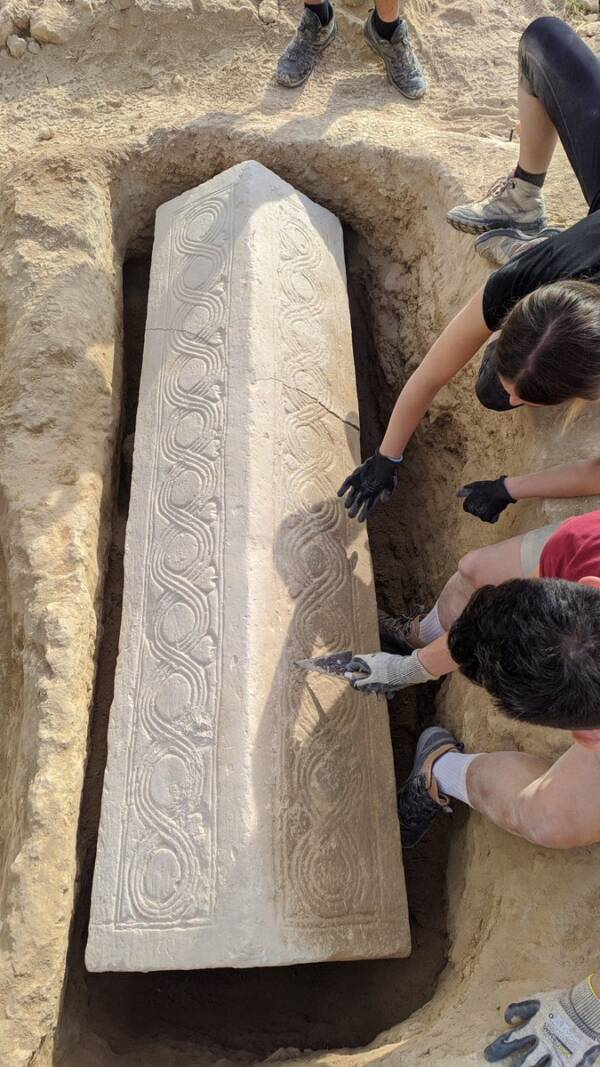Archeologists from the University of Murcia came across the 1,500-year-old Visigoth sarcophagus at the Roman necropolis of Los Villaricos.

University of MurciaThe Visigoth sarcophagus that was unearthed in Mula, Spain.
As they knelt in the dust and the heat, searching the former Roman settlement of Los Villaricos for history’s treasures, archeologists came across an incredible discovery. There, buried in pale yellow dirt, they found a 1,500-year-old Visigoth sarcophagus — complete with human remains.
“We weren’t expecting this spectacular discovery,” said Professor Rafael González Fernández of the University of Murcia, who led the excavation.
The sarcophagus, about six feet long and in remarkably good condition, likely dates to the 6th or 7th century A.D. It features elaborate designs across its top, including a coiled geometric pattern, ivy leaves, and the Chi Rho sign. That sign appears frequently in Christian artwork to signify the victory of the Resurrection.
Archeologists came across the sarcophagus during an annual excavation of the former Roman settlement. As González explained:
“This year’s campaign was focused on finishing excavating the last three burials of the necropolis and continuing with the excavation work of the complex located to the north of the town, where in the last few years we had documented a new set of pools.”
But, instead, they came across something entirely “unexpected” — a stunning sarcophagus. The piece was buried by the Visigoths, who replaced the Romans in the region following the fall of the Roman Empire.

University of MurciaThe sarcophagus is elaborately designed and well-preserved.
For hundreds of years, ancient Romans lived and thrived at the settlement of Los Villaricos. They enjoyed the bounty of the region, which provided silver for coins, wheat to feed troops, and other materials like olive oil, marble, and sandstone.
Over the years, they lay down elaborate mosaic floors, constructed thermal baths, and built an olive press.
But the peaceful prosperity of Los Villaricos did not last. As the age of the Romans waned, a new threat showed up on the horizon: the Visigoths.
The Visigoths, an early Germanic people, swept south during the 3rd and 5th centuries A.D. As the Roman Empire collapsed around the same time, the Visigoths launched invasions into former Roman territories.

University of MurciaRuins of the Roman settlement can be seen in the background of the sarcophagus.
By the early 6th century, Romans largely abandoned the agricultural villa of Los Villaricos. But a few people stayed behind. And as the Visigoths moved in, these former Roman citizens transformed their lives to match the invaders. They built a semi-circular building for religious purposes and a burial ground for the dead nearby.
That’s where the archeologists from the University of Murcia made their astounding find. It’s significant because, according to González, the sarcophagus, “corroborates previous studies on the chronology of the necropolis.”
Given that the sarcophagus appears to date from the 6th or 7th century A.D., it fits in neatly with how archeologists understand the timeline of Los Villaricos — from its heyday as a Roman settlement until the 5th or 6th century, to its invasion and occupation by Germanic Visigoths.
Certainly, it appears that archeologists have more to discover at the ancient site. But, for now, its present-day occupants are thrilled at the recent discovery.
The mayor of Mula, Juan Jesús Moreno, pledged that the “commitment of the City Council of Mula and the entire Corporation with the archaeological works is absolute.” He believes that the sarcophagus will “without a doubt… occupy a prominent place in the Museo Ciudad de Mula.”
And Murcia’s Director of Heritage, María Dolores Sánchez Alarcón, is similarly thrilled by the discovery.
“This is a very important moment for the region and I am very excited to be at this site,” Sánchez said. “I just want to convey my joy and my pride in seeing that perspective of a sustainable future.”
The research team at Los Villaricos, which was reduced to just 16 people because of the coronavirus pandemic, will continue to dig for a few more days. Until July 24, they’ll continue to search for clues to the past. And who knows what they may find?
After reading about the Visigoth sarcophagus found in Spain, discover the mystery of the corpses found at Stonehenge. Or, learn about the small town in Spain that keeps getting hit by space junk.





